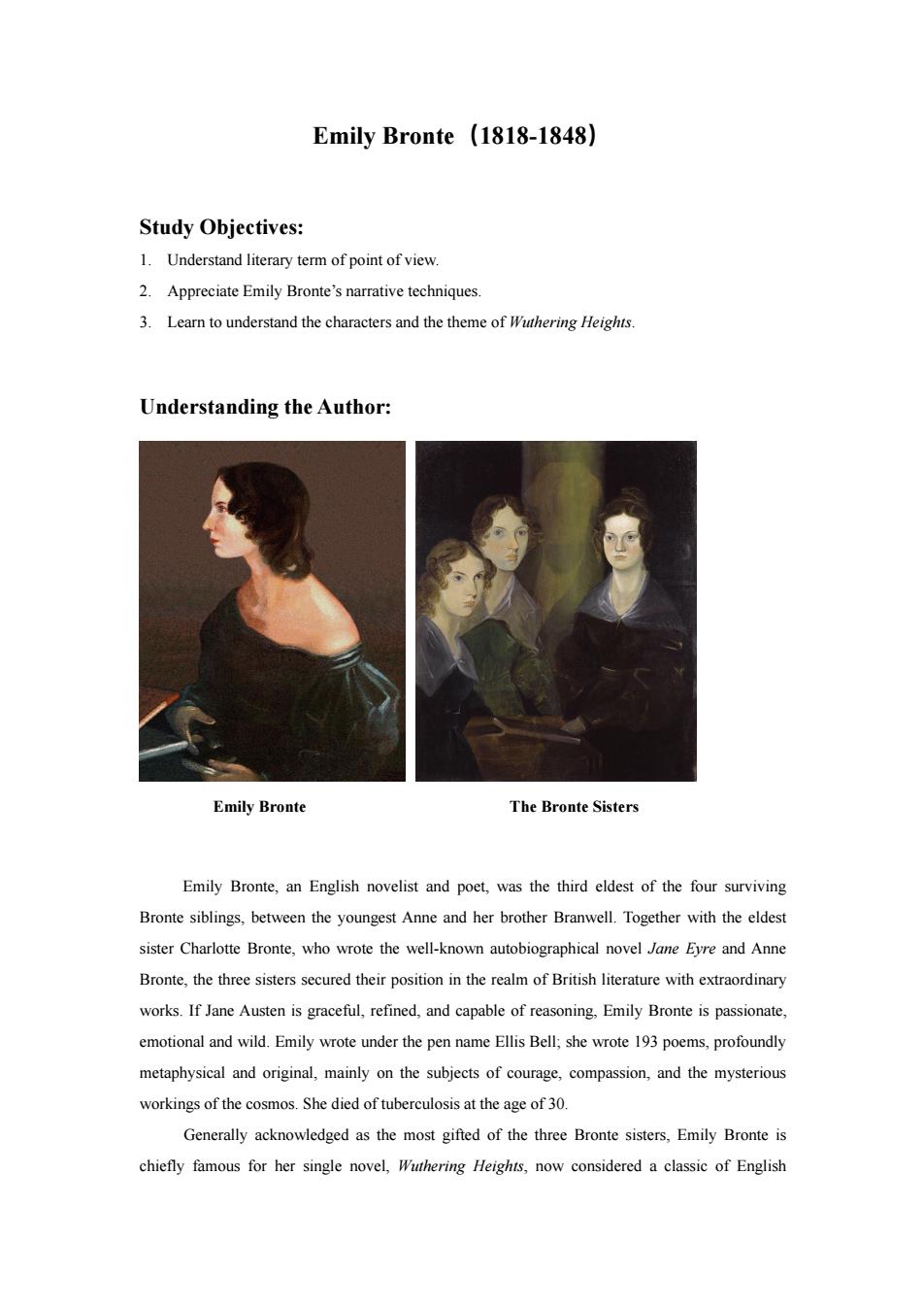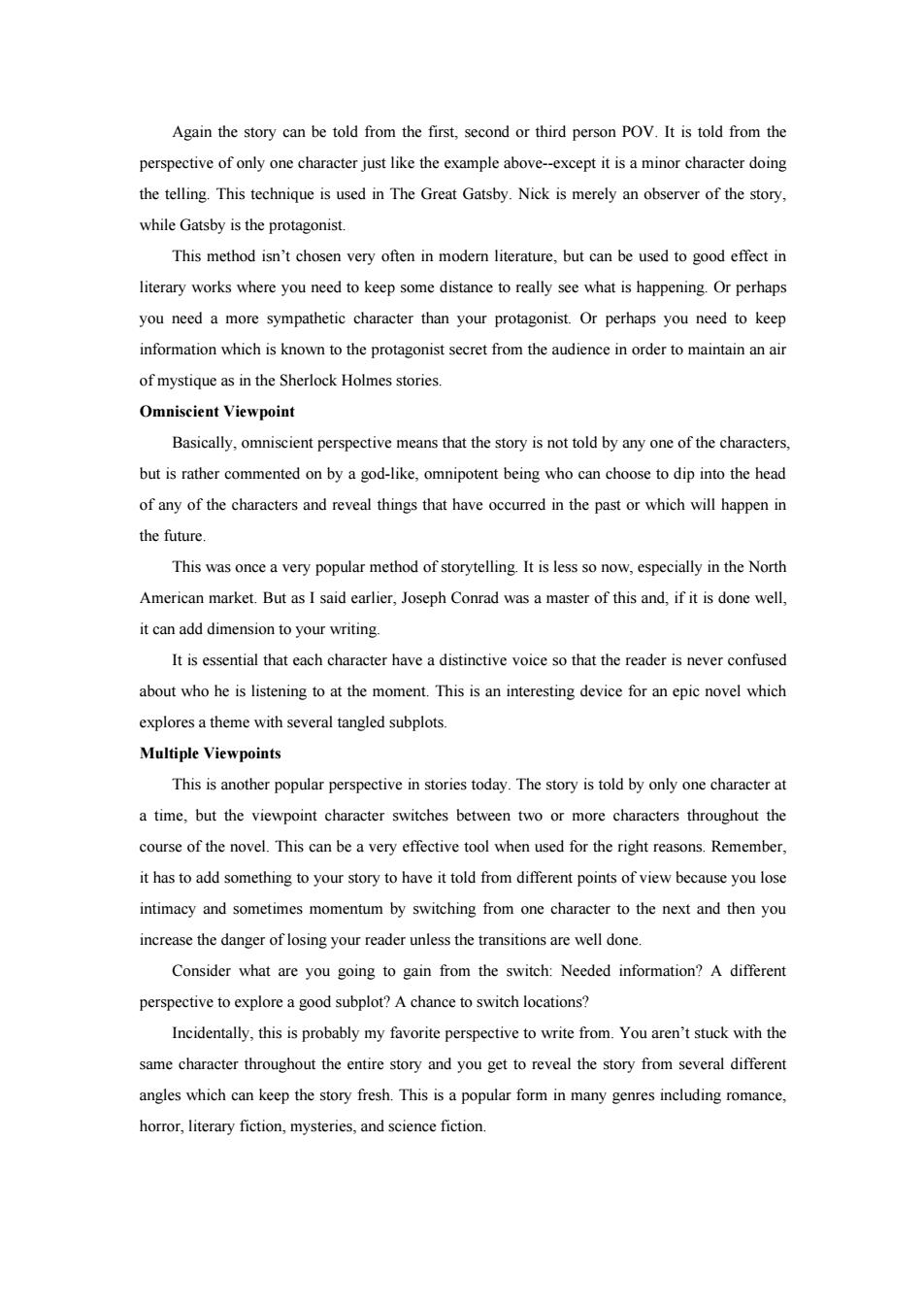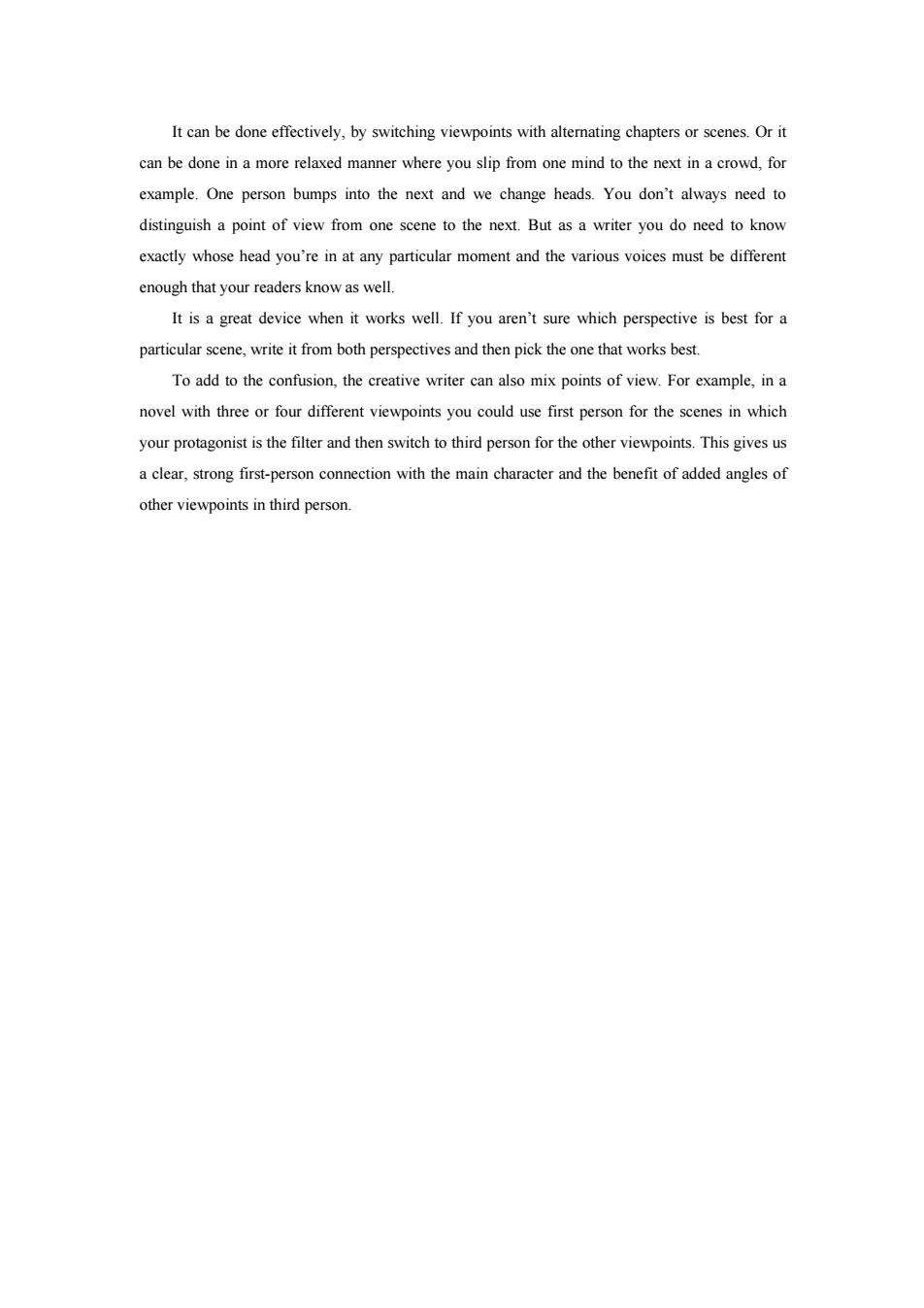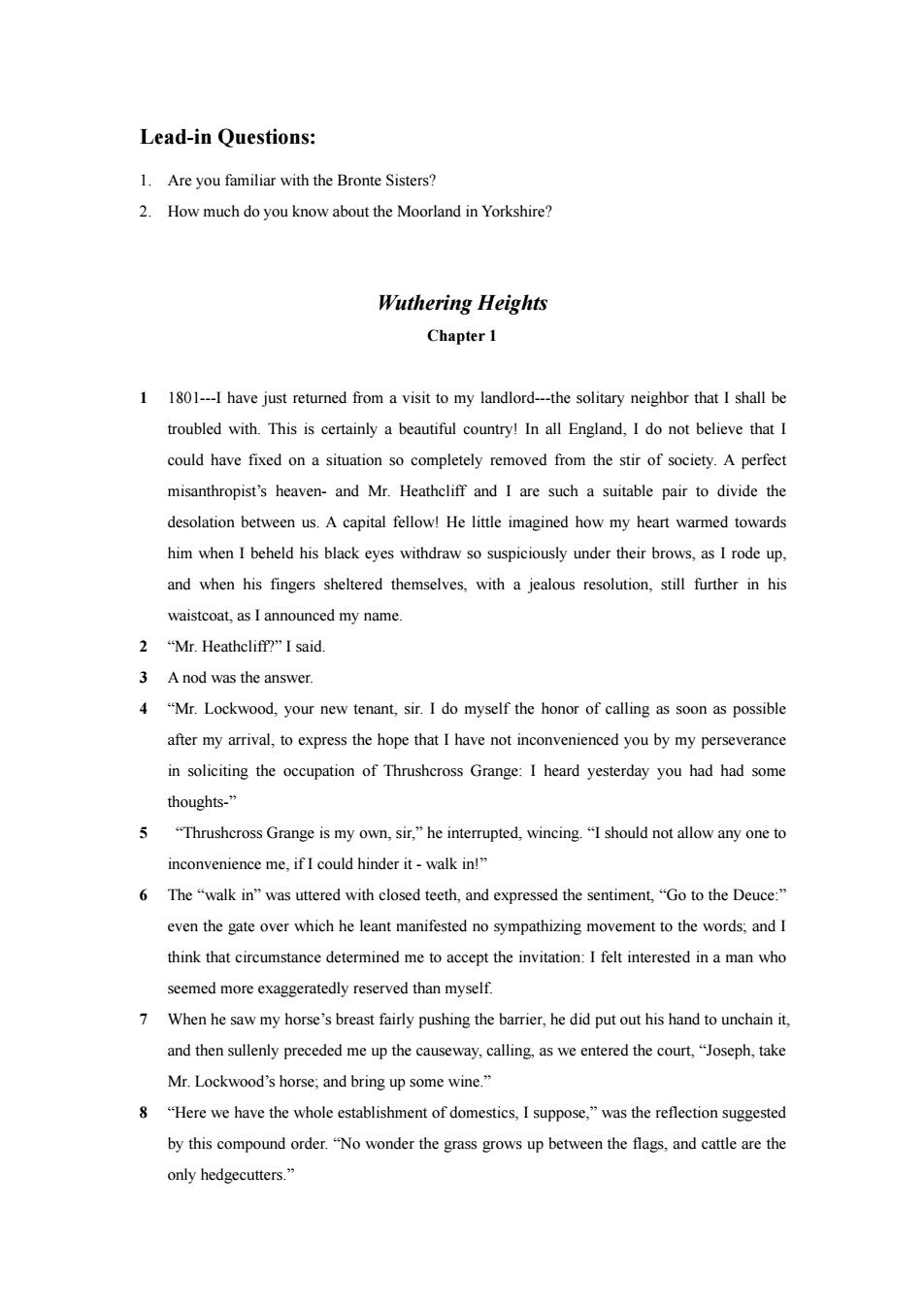
Emily Bronte (1818-1848) Study Objectives: 1.Understand literary term of point of view. 2.Appreciate Emily Bronte's narrative techniques. 3.Learn to understand the characters and the theme of Wuthering Heights. Understanding the Author: Emily Bronte The Bronte Sisters Emily Bronte,an English novelist and poet,was the third eldest of the four surviving Bronte siblings,between the youngest Anne and her brother Branwell.Together with the eldest sister Charlotte Bronte,who wrote the well-known autobiographical novel Jane Eyre and Anne Bronte,the three sisters secured their position in the realm of British literature with extraordinary works.If Jane Austen is graceful,refined,and capable of reasoning,Emily Bronte is passionate, emotional and wild.Emily wrote under the pen name Ellis Bell;she wrote 193 poems,profoundly metaphysical and original,mainly on the subjects of courage,compassion,and the mysterious workings of the cosmos.She died of tuberculosis at the age of 30. Generally acknowledged as the most gifted of the three Bronte sisters,Emily Bronte is chiefly famous for her single novel,Wuthering Heights,now considered a classic of English
Emily Bronte(1818-1848) Study Objectives: 1. Understand literary term of point of view. 2. Appreciate Emily Bronte’s narrative techniques. 3. Learn to understand the characters and the theme of Wuthering Heights. Understanding the Author: Emily Bronte The Bronte Sisters Emily Bronte, an English novelist and poet, was the third eldest of the four surviving Bronte siblings, between the youngest Anne and her brother Branwell. Together with the eldest sister Charlotte Bronte, who wrote the well-known autobiographical novel Jane Eyre and Anne Bronte, the three sisters secured their position in the realm of British literature with extraordinary works. If Jane Austen is graceful, refined, and capable of reasoning, Emily Bronte is passionate, emotional and wild. Emily wrote under the pen name Ellis Bell; she wrote 193 poems, profoundly metaphysical and original, mainly on the subjects of courage, compassion, and the mysterious workings of the cosmos. She died of tuberculosis at the age of 30. Generally acknowledged as the most gifted of the three Bronte sisters, Emily Bronte is chiefly famous for her single novel, Wuthering Heights, now considered a classic of English

literature.Published in 1847,Wuthering Heights is remarkable for many reasons,one of which,is its exceptionally mature plot and narrative structure.The development of the plot is cyclic:from relative peace and harmony to violence,destruction,and suffering,and thence on to final and conclusive harmony again.The narrative structure is unique in the sense that the story is told through two independent narrators,Mr.Lockwood,a conventional gentleman who is disgusted with society,went to rural Yorkshire.As a tenant of Thrushcross Grange,he visited Wuthering Heights,the nearest neighbor and was shocked to see the naked hatred and violence among the family members of Wuthering Heights:Hareton,Heathcliff,Little Cathy.He gradually learns the stormy love between Heathcliff and Catherine from Nelly Dean,the practical,unimaginative housekeeper.Their narration removes the reader from direct contact with the wild and improbable events.This slight distancing reduces the degree of the horror as well as the improbability.By filtering the events through Mr.Lockwood's and Nelly Dean's minds,the reader may accept the extraordinary story although they may be appalled at it. Understanding Point of View: The following introduction is from "The Writer's Craf” (http://www.the-writers-craft.com/point-of-view-in-literature-perspectives.html): Point of View in Literature--Perspectives In order to fully understand point of view in literature,we need to explore the different perspectives from which a story may be told.Bear in mind that the Perspective is the scene as viewed through the eyes/mind of the chosen character.The story,however,can be told from any one of several points-of-view regardless of the perspective chosen. Single Major Character Viewpoint The story can be told from first,second or third person POV but it is told throughout by just one character.The reader discovers everything in the story at exactly the same time as the viewpoint character does.You cannot hint at things that are to come if the main character doesn't know they are coming.You cannot give the character unnatural foresight-unless of course he is psychic. The single-character perspective is the most common viewpoint used in children's literature and a lot of adult literature as well.It allows you all the descriptive forces of third person and almost as much intimacy as first person.It is much easier for the reader to identify with just one character. Minor Character Viewpoint
literature. Published in 1847, Wuthering Heights is remarkable for many reasons, one of which, is its exceptionally mature plot and narrative structure. The development of the plot is cyclic: from relative peace and harmony to violence, destruction, and suffering, and thence on to final and conclusive harmony again. The narrative structure is unique in the sense that the story is told through two independent narrators, Mr. Lockwood, a conventional gentleman who is disgusted with society, went to rural Yorkshire. As a tenant of Thrushcross Grange, he visited Wuthering Heights, the nearest neighbor and was shocked to see the naked hatred and violence among the family members of Wuthering Heights: Hareton, Heathcliff, Little Cathy. He gradually learns the stormy love between Heathcliff and Catherine from Nelly Dean, the practical, unimaginative housekeeper. Their narration removes the reader from direct contact with the wild and improbable events. This slight distancing reduces the degree of the horror as well as the improbability. By filtering the events through Mr. Lockwood’s and Nelly Dean’s minds, the reader may accept the extraordinary story although they may be appalled at it. Understanding Point of View: The following introduction is from “The Writer’s Craft” (http://www.the-writers-craft.com/point-of-view-in-literature-perspectives.html): Point of View in Literature -- Perspectives In order to fully understand point of view in literature, we need to explore the different perspectives from which a story may be told. Bear in mind that the Perspective is the scene as viewed through the eyes/mind of the chosen character. The story, however, can be told from any one of several points-of-view regardless of the perspective chosen. Single Major Character Viewpoint The story can be told from first, second or third person POV but it is told throughout by just one character. The reader discovers everything in the story at exactly the same time as the viewpoint character does. You cannot hint at things that are to come if the main character doesn’t know they are coming. You cannot give the character unnatural foresight-unless of course he is psychic. The single-character perspective is the most common viewpoint used in children’s literature and a lot of adult literature as well. It allows you all the descriptive forces of third person and almost as much intimacy as first person. It is much easier for the reader to identify with just one character. Minor Character Viewpoint

Again the story can be told from the first,second or third person POV.It is told from the perspective of only one character just like the example above--except it is a minor character doing the telling.This technique is used in The Great Gatsby.Nick is merely an observer of the story, while Gatsby is the protagonist. This method isn't chosen very often in modern literature,but can be used to good effect in literary works where you need to keep some distance to really see what is happening.Or perhaps you need a more sympathetic character than your protagonist.Or perhaps you need to keep information which is known to the protagonist secret from the audience in order to maintain an air of mystique as in the Sherlock Holmes stories. Omniscient Viewpoint Basically,omniscient perspective means that the story is not told by any one of the characters, but is rather commented on by a god-like,omnipotent being who can choose to dip into the head of any of the characters and reveal things that have occurred in the past or which will happen in the future. This was once a very popular method of storytelling.It is less so now,especially in the North American market.But as I said earlier,Joseph Conrad was a master of this and,if it is done well, it can add dimension to your writing. It is essential that each character have a distinctive voice so that the reader is never confused about who he is listening to at the moment.This is an interesting device for an epic novel which explores a theme with several tangled subplots. Multiple Viewpoints This is another popular perspective in stories today.The story is told by only one character at a time,but the viewpoint character switches between two or more characters throughout the course of the novel.This can be a very effective tool when used for the right reasons.Remember, it has to add something to your story to have it told from different points of view because you lose intimacy and sometimes momentum by switching from one character to the next and then you increase the danger of losing your reader unless the transitions are well done. Consider what are you going to gain from the switch:Needed information?A different perspective to explore a good subplot?A chance to switch locations? Incidentally,this is probably my favorite perspective to write from.You aren't stuck with the same character throughout the entire story and you get to reveal the story from several different angles which can keep the story fresh.This is a popular form in many genres including romance, horror,literary fiction,mysteries,and science fiction
Again the story can be told from the first, second or third person POV. It is told from the perspective of only one character just like the example above--except it is a minor character doing the telling. This technique is used in The Great Gatsby. Nick is merely an observer of the story, while Gatsby is the protagonist. This method isn’t chosen very often in modern literature, but can be used to good effect in literary works where you need to keep some distance to really see what is happening. Or perhaps you need a more sympathetic character than your protagonist. Or perhaps you need to keep information which is known to the protagonist secret from the audience in order to maintain an air of mystique as in the Sherlock Holmes stories. Omniscient Viewpoint Basically, omniscient perspective means that the story is not told by any one of the characters, but is rather commented on by a god-like, omnipotent being who can choose to dip into the head of any of the characters and reveal things that have occurred in the past or which will happen in the future. This was once a very popular method of storytelling. It is less so now, especially in the North American market. But as I said earlier, Joseph Conrad was a master of this and, if it is done well, it can add dimension to your writing. It is essential that each character have a distinctive voice so that the reader is never confused about who he is listening to at the moment. This is an interesting device for an epic novel which explores a theme with several tangled subplots. Multiple Viewpoints This is another popular perspective in stories today. The story is told by only one character at a time, but the viewpoint character switches between two or more characters throughout the course of the novel. This can be a very effective tool when used for the right reasons. Remember, it has to add something to your story to have it told from different points of view because you lose intimacy and sometimes momentum by switching from one character to the next and then you increase the danger of losing your reader unless the transitions are well done. Consider what are you going to gain from the switch: Needed information? A different perspective to explore a good subplot? A chance to switch locations? Incidentally, this is probably my favorite perspective to write from. You aren’t stuck with the same character throughout the entire story and you get to reveal the story from several different angles which can keep the story fresh. This is a popular form in many genres including romance, horror, literary fiction, mysteries, and science fiction

It can be done effectively,by switching viewpoints with alternating chapters or scenes.Or it can be done in a more relaxed manner where you slip from one mind to the next in a crowd,for example.One person bumps into the next and we change heads.You don't always need to distinguish a point of view from one scene to the next.But as a writer you do need to know exactly whose head you're in at any particular moment and the various voices must be different enough that your readers know as well It is a great device when it works well.If you aren't sure which perspective is best for a particular scene,write it from both perspectives and then pick the one that works best. To add to the confusion,the creative writer can also mix points of view.For example,in a novel with three or four different viewpoints you could use first person for the scenes in which your protagonist is the filter and then switch to third person for the other viewpoints.This gives us a clear,strong first-person connection with the main character and the benefit of added angles of other viewpoints in third person
It can be done effectively, by switching viewpoints with alternating chapters or scenes. Or it can be done in a more relaxed manner where you slip from one mind to the next in a crowd, for example. One person bumps into the next and we change heads. You don’t always need to distinguish a point of view from one scene to the next. But as a writer you do need to know exactly whose head you’re in at any particular moment and the various voices must be different enough that your readers know as well. It is a great device when it works well. If you aren’t sure which perspective is best for a particular scene, write it from both perspectives and then pick the one that works best. To add to the confusion, the creative writer can also mix points of view. For example, in a novel with three or four different viewpoints you could use first person for the scenes in which your protagonist is the filter and then switch to third person for the other viewpoints. This gives us a clear, strong first-person connection with the main character and the benefit of added angles of other viewpoints in third person

Lead-in Questions: 1.Are you familiar with the Bronte Sisters? 2.How much do you know about the Moorland in Yorkshire? Wuthering Heights Chapter 1 1 1801---I have just returned from a visit to my landlord---the solitary neighbor that I shall be troubled with.This is certainly a beautiful country!In all England,I do not believe that I could have fixed on a situation so completely removed from the stir of society.A perfect misanthropist's heaven-and Mr.Heathcliff and I are such a suitable pair to divide the desolation between us.A capital fellow!He little imagined how my heart warmed towards him when I beheld his black eyes withdraw so suspiciously under their brows,as I rode up, and when his fingers sheltered themselves,with a jealous resolution,still further in his waistcoat,as I announced my name. 2 "Mr.Heathcliff?"I said. 3 A nod was the answer. 4 "Mr.Lockwood,your new tenant,sir.I do myself the honor of calling as soon as possible after my arrival,to express the hope that I have not inconvenienced you by my perseverance in soliciting the occupation of Thrushcross Grange:I heard yesterday you hadhad some thoughts-” 5 "Thrushcross Grange is my own,sir,"he interrupted,wincing."I should not allow any one to inconvenience me,if I could hinder it-walk in!" 6 The"walk in"was uttered with closed teeth,and expressed the sentiment,"Go to the Deuce:" even the gate over which he leant manifested no sympathizing movement to the words;and I think that circumstance determined me to accept the invitation:I felt interested in a man who seemed more exaggeratedly reserved than myself. 7 When he saw my horse's breast fairly pushing the barrier,he did put out his hand to unchain it, and then sullenly preceded me up the causeway,calling,as we entered the court,"Joseph,take Mr.Lockwood's horse;and bring up some wine." 8 "Here we have the whole establishment of domestics,I suppose,"was the reflection suggested by this compound order."No wonder the grass grows up between the flags,and cattle are the only hedgecutters
Lead-in Questions: 1. Are you familiar with the Bronte Sisters? 2. How much do you know about the Moorland in Yorkshire? Wuthering Heights Chapter 1 1 1801---I have just returned from a visit to my landlord---the solitary neighbor that I shall be troubled with. This is certainly a beautiful country! In all England, I do not believe that I could have fixed on a situation so completely removed from the stir of society. A perfect misanthropist’s heaven- and Mr. Heathcliff and I are such a suitable pair to divide the desolation between us. A capital fellow! He little imagined how my heart warmed towards him when I beheld his black eyes withdraw so suspiciously under their brows, as I rode up, and when his fingers sheltered themselves, with a jealous resolution, still further in his waistcoat, as I announced my name. 2 “Mr. Heathcliff?” I said. 3 A nod was the answer. 4 “Mr. Lockwood, your new tenant, sir. I do myself the honor of calling as soon as possible after my arrival, to express the hope that I have not inconvenienced you by my perseverance in soliciting the occupation of Thrushcross Grange: I heard yesterday you had had some thoughts-” 5 “Thrushcross Grange is my own, sir,” he interrupted, wincing. “I should not allow any one to inconvenience me, if I could hinder it - walk in!” 6 The “walk in” was uttered with closed teeth, and expressed the sentiment, “Go to the Deuce:” even the gate over which he leant manifested no sympathizing movement to the words; and I think that circumstance determined me to accept the invitation: I felt interested in a man who seemed more exaggeratedly reserved than myself. 7 When he saw my horse’s breast fairly pushing the barrier, he did put out his hand to unchain it, and then sullenly preceded me up the causeway, calling, as we entered the court, “Joseph, take Mr. Lockwood’s horse; and bring up some wine.” 8 “Here we have the whole establishment of domestics, I suppose,” was the reflection suggested by this compound order. “No wonder the grass grows up between the flags, and cattle are the only hedgecutters